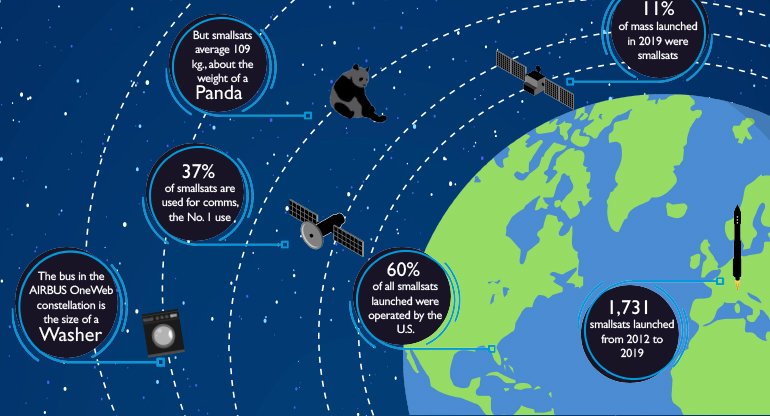With smallsats, satellites are shrinking to speed manufacture and cut costs, cycle times, and risk
Growing worldwide commercialization and exploration of space significantly benefit every industry – from academia to government and defense. Part of this new space revolution is the increasing use and advancement of small satellites, or smallsats. Smallsats typically weigh 500 kilograms or less and have less mass than traditional satellites.
The legacy approach to satellite development has been to make a few “robust” satellites that push the technical envelope, are highly reliable, and last more than 15 years. This approach is expensive and high-risk, and it involves slow design cycles, long life spans, and low production rates. The observation or communication swaths are linear and have to be statically organized in a constellation that is already overpopulated.
Smallsats are the next innovation
Smallsats are replacing their less nimble predecessors on a growing basis because they are less expensive and require fewer resources to create, launch, and monitor. They can also be manufactured faster, using standardized and commercially available technology, which means more satellites can be launched for a set budget. Building smaller, less expensive satellites not only reduces financial risk, but it also lessens mission failure risk compared to putting “all your eggs in one basket” with one large satellite.
The smallsats can be configured for communications and instrument bearing. They can be generic platforms, able to be reconfigured for follow-on missions. The network within the constellation increases the functional options to direct the proximity and focus of smallsat placement.
Smallsats can make space exploration opportunities more accessible not only for the satellite industry and the U.S. government but also for the private sector.
Small but mighty
As a result of advancing and enabling technologies, smallsat capabilities are becoming more effective. Smallsats deliver access to information from a larger volume of spacecraft for quicker relay of more data. For example, proliferated low Earth orbit (pLEO) constellations are more viable using smallsats, and companies and the space industry are taking advantage of this.
Smallsats and constellations will increasingly be used for affordable space missions including academic and professional science experiments, commercial space-based services, military tactical communications, and remote sensing. Future constellations can be segmented to perform different, multiple missions in parallel. Constellations can be geosynchronous, geostationary, or even hybrid in nature to adapt to planetary zones of interest.
Companies and the space industry are harnessing the low-cost, rapid development, and simplified design benefits of smallsats to develop and test the margins of their research constellations. Smallsats are being incrementally populated into a constellation to provide insights and opportunities to incorporate lessons learned for future missions. Furthermore, with this strategy, companies can integrate new, cutting-edge technologies to evaluate performance and then make adjustments for future missions rather than playing it safe with aging technologies.
Bringing digitization to the smallsat community
The U.S. government has recognized the cost, speed, and resilience benefits of the proliferated smallsat acquisition approach for its next-generation defense needs, and SAIC is involved in achieving smallsat solutions.
SAIC brings unique, notable background and experience in supporting traditional satellite programs, including designing mission requirements and performing systems engineering and integration. We pursued strategic partnerships, which provide vehicle engineering and design expertise. We design and optimize missions and systems integration using smallsats and apply lessons learned on long-team system operation.
Digital thread expertise accelerates outcomes
Our defense space mission design background includes modeling and simulation and digital engineering (DE). We design a mission around a defense customer's requirements and model the parameters and performance using our DE ecosystem of tools. We then connect the simulation to models of the architecture, needs, and usage. This is crucial with smallsat design to cut time from inception to deployment and cost for the customer.
Together with the customer, we deploy our knowledge of the Joint Range Extension Applications Protocol for Link 16 tactical data link extension over long distances, source the latest commercially available technology payloads — sensors, processors, and more — and design and produce the smallsat for ground to space operations. We leverage our center of excellence for artificial intelligence and machine learning to assist with ground and space systems data transfer and integration and to simplify and automate operations and tasks.
SAIC believes smallsat technology will easily advance space missions and exploration strategies into the next realm of humanity-affecting possibilities.


